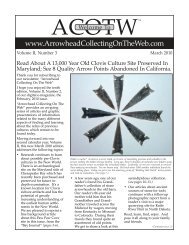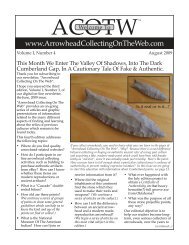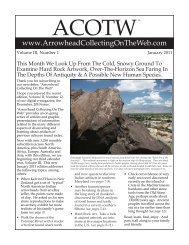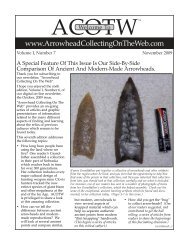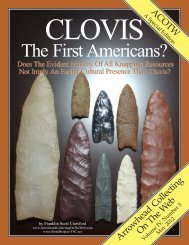Rock, Paper, Scissors - Arrowhead Collecting On The Web
Rock, Paper, Scissors - Arrowhead Collecting On The Web
Rock, Paper, Scissors - Arrowhead Collecting On The Web
You also want an ePaper? Increase the reach of your titles
YUMPU automatically turns print PDFs into web optimized ePapers that Google loves.
ACOTW<br />
<strong>Arrowhead</strong> <strong>Collecting</strong> <strong>On</strong> <strong>The</strong> <strong>Web</strong><br />
<strong>Arrowhead</strong> <strong>Collecting</strong> <strong>On</strong> <strong>The</strong> <strong>Web</strong><br />
assemblages, and many archaeologists working in the<br />
northern Sierra Nevada have experimented with knapping<br />
basalts (e.g.. Rondeau 1980; Bloomer et al. 1997; D. Stevens,<br />
personal communication 2000).<br />
However, the relative<br />
intractability of basalt<br />
for biface manufacture<br />
has discouraged<br />
experimentation that<br />
would be extensive<br />
enough to test a<br />
diversity of knapping<br />
strategies. Knappers<br />
accustomed to<br />
obsidian or chert<br />
fi nd their skills<br />
tested to the limits by<br />
basalt.<br />
Perhaps the most<br />
serious obstacle is the<br />
cumulative damage<br />
to joints (fi ngers,<br />
hands, wrists, elbows,<br />
shoulders, and neck)<br />
caused by a sustained<br />
program of percussion and<br />
pressure of this demanding<br />
material (cf. Callahan and<br />
Titmus 1999). Despite such<br />
limitations, and even though<br />
further experimentation is<br />
needed, replicative studies<br />
reported here shed light on<br />
assemblage variability and typology.<br />
Originally introduced to the art<br />
by Glynn Isaac, eminent African<br />
prehistorian then teaching at the<br />
University of California, Berkeley, the<br />
author has been a knapper since 1976. Initial<br />
interest was in the African Lower Paleolithic and<br />
the analysis of large bifaces (Edwards 2001).<br />
Authentic replication entailed experimentation with<br />
many raw materials, but especially basalt, one of the<br />
two most widely used materials in Africa (the other being<br />
quartz ite). More recently, the author turned his att ention to<br />
Martis technology, and over a period of four years, a number<br />
of Martis replicas were att empted. <strong>The</strong> hope was to learn as<br />
much as possible about the technological skills and strategies<br />
refl ected in Martis fl aked stone assemblages.<br />
APPROACH AND DEFINITIONS<br />
From 1997 to 2000, extensive replicative experiments were<br />
conducted using basalt collected at Alder Hill/Prosser Lake<br />
in Nevada County, California, and at several sites in the<br />
Lakes Basin/Gold Lake area of Sierra County (see map, p. 18).<br />
Using a variety of techniques, crude and refi ned bifaces were<br />
replicated, as well as expedient and refi ned projectile points,<br />
in both fi ne- and coarse-grained basalts. Four diff erent kinds<br />
of percussors were used, including antler baton, wood baton,<br />
hard hammerstone, and soft hammer stone. <strong>The</strong> time<br />
TM This Paleo Indian period unifacial Basalt Knife from<br />
Payett e County, Idaho, measures 8-1/2” long by 3-3/4” wide.<br />
Shown here at 75% of actual size. This is the back face of<br />
the knife, which was unchanged by the ancient knapper.<br />
Illustrative photographs by the publisher of ACOTW.<br />
required for each replication was recorded, along with notes<br />
on strategy and results.<br />
This work was combined with a literature review, a<br />
study of collections housed at Tahoe National Forest, and<br />
an examination of artifacts in known surface scatt ers,<br />
especially at Alder Hill/Prosser Lake and at four sites in<br />
the Lakes Basin area.<br />
“Refi ned” refers to a projectile point or biface<br />
with relatively straight edges in edge view,<br />
symmetrical plan form, fairly symmetrical<br />
cross section (“camber”), near absence of<br />
steps, and an organized fl ake scar patt ern.<br />
It may be thick or thin but, all else held<br />
equal, thinner is more refi ned. “Crude”<br />
bifaces or points tend to have the<br />
opposite of all these att ributes. An<br />
“expedient” projectile point is a<br />
crude one. Expedient points with<br />
a minimum of fl ake scars—most<br />
of them noninvasive so that<br />
the desired functional shape is<br />
achieved with a minimum of eff ort<br />
should theoretically prove more<br />
common in areas where raw<br />
materials are more coarse.<br />
TECHNOLOGICAL<br />
OBSERVATIONS<br />
Martis knappers were<br />
highly skilled at working<br />
with basalt, as illustrated<br />
in Elsasser (1960:Plate<br />
I), Neuenschwander<br />
(1994:see top, p. 17).<br />
Any knapping session<br />
in basalt is always<br />
problematical at the<br />
outset, given the<br />
diffi culty of the stone.<br />
Nevertheless, Martis<br />
knappers achieved<br />
complete control of<br />
att ributes suffi ciently<br />
often that it is clear they<br />
equaled in skill the best<br />
modern knappers.<br />
Raw material quality diff ers<br />
dramatically between Martis<br />
quarries. <strong>The</strong> basalt of Oakland Pond in Plumas County,<br />
California (Bloomer and Hall 1998), is the fi nest of all. <strong>The</strong><br />
various grades distributed around Gold Lake/Lakes Basin/<br />
Church Meadows (including Oakland Pond) are generally<br />
fi ner grained and glassier than sources near Truckee, Squaw<br />
Valley, and Lake Tahoe in Nevada County and Placer<br />
County (Davis 1958; Duke 1998b; Ataman et al. 1999), (see<br />
map, p. 18). Some archaeologists employ the whimsical term<br />
“basidian” for the former sources. Workability is drastically<br />
diff erent between the basalts in these areas. Lakes Basin<br />
basalts are far more controllable; outcomes of percussion are<br />
more predictable and pressure fl aking is far<br />
Volume II, Number 12 12<br />
December 2010



